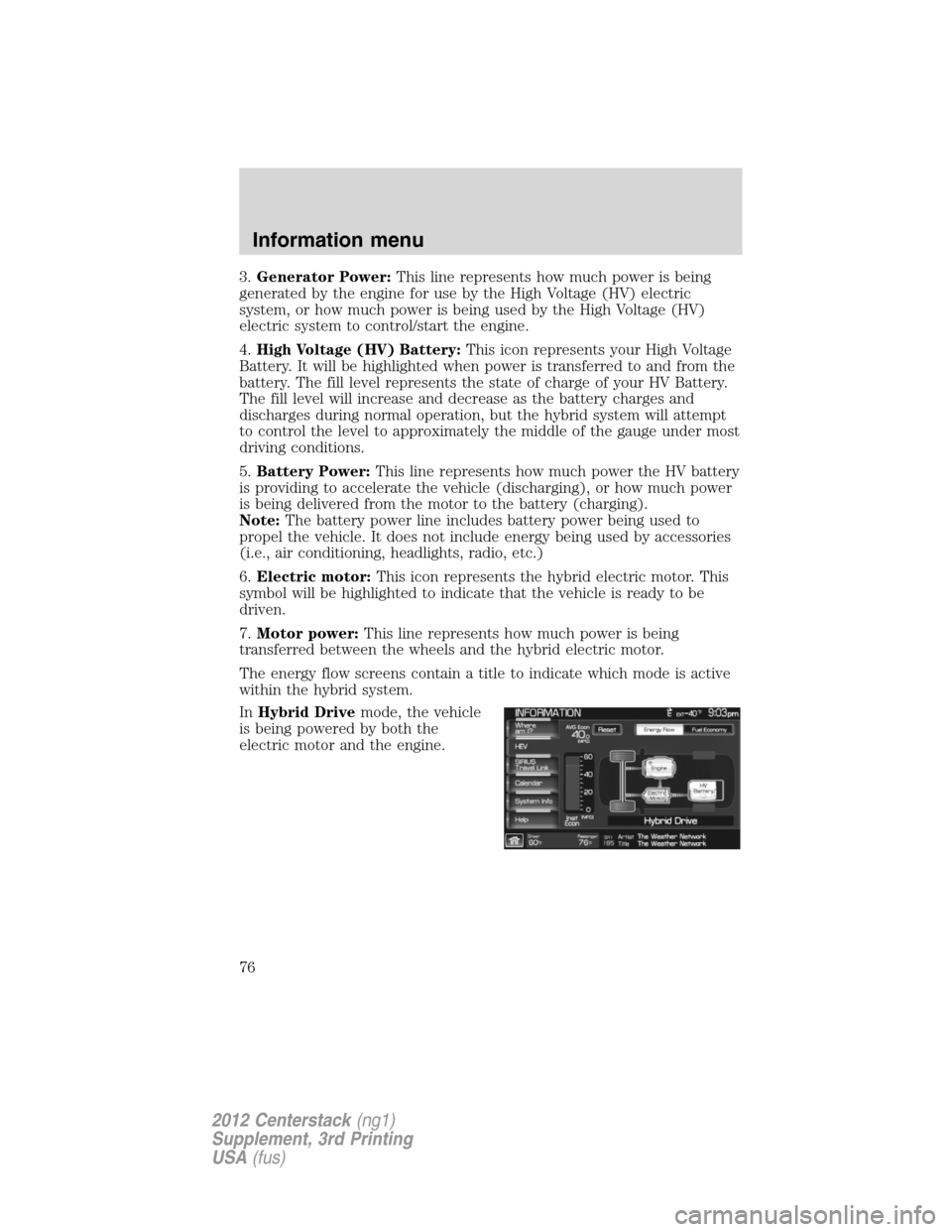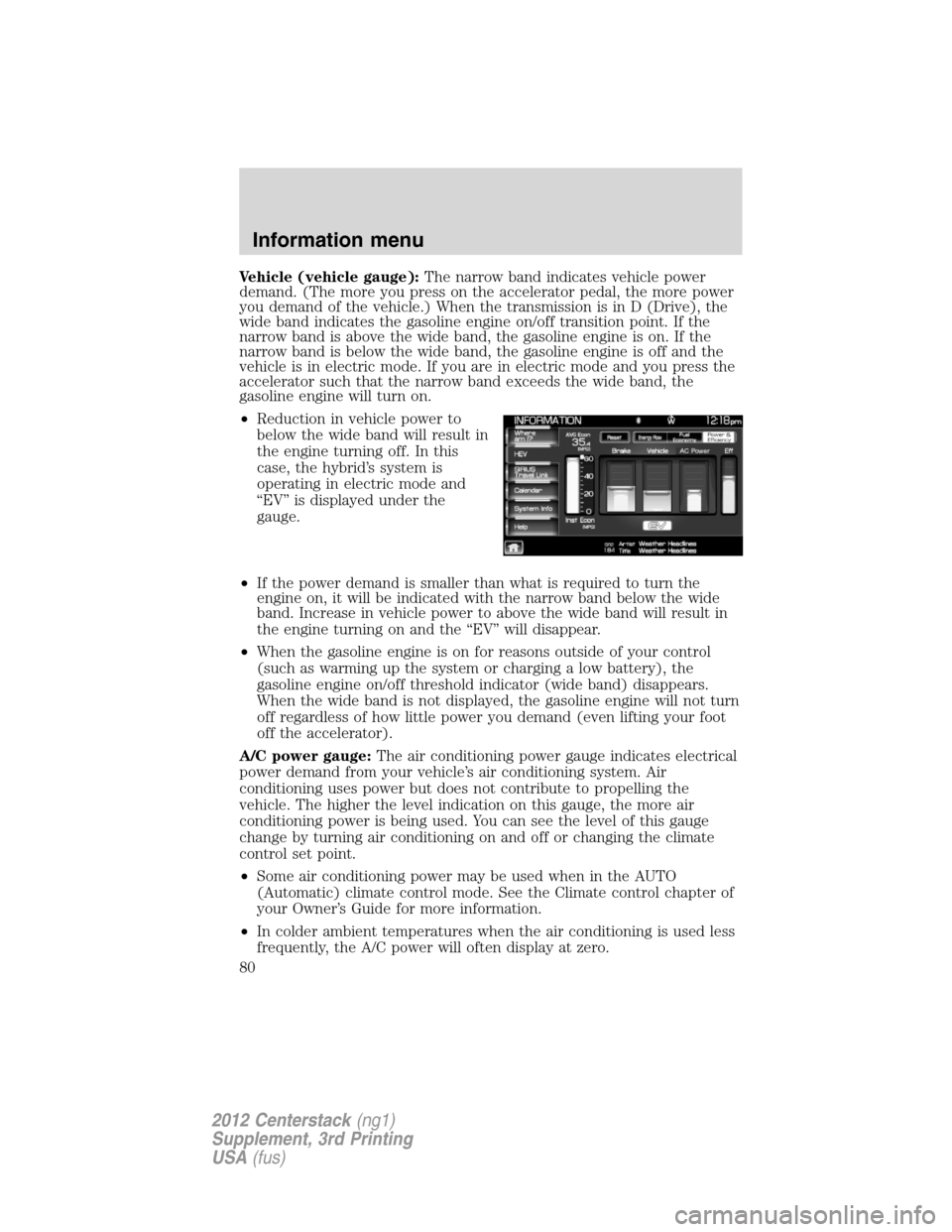air conditioning LINCOLN MKZ 2012 Navigation Manual
[x] Cancel search | Manufacturer: LINCOLN, Model Year: 2012, Model line: MKZ, Model: LINCOLN MKZ 2012Pages: 200, PDF Size: 3.37 MB
Page 76 of 200

3.Generator Power:This line represents how much power is being
generated by the engine for use by the High Voltage (HV) electric
system, or how much power is being used by the High Voltage (HV)
electric system to control/start the engine.
4.High Voltage (HV) Battery:This icon represents your High Voltage
Battery. It will be highlighted when power is transferred to and from the
battery. The fill level represents the state of charge of your HV Battery.
The fill level will increase and decrease as the battery charges and
discharges during normal operation, but the hybrid system will attempt
to control the level to approximately the middle of the gauge under most
driving conditions.
5.Battery Power:This line represents how much power the HV battery
is providing to accelerate the vehicle (discharging), or how much power
is being delivered from the motor to the battery (charging).
Note:The battery power line includes battery power being used to
propel the vehicle. It does not include energy being used by accessories
(i.e., air conditioning, headlights, radio, etc.)
6.Electric motor:This icon represents the hybrid electric motor. This
symbol will be highlighted to indicate that the vehicle is ready to be
driven.
7.Motor power:This line represents how much power is being
transferred between the wheels and the hybrid electric motor.
The energy flow screens contain a title to indicate which mode is active
within the hybrid system.
InHybrid Drivemode, the vehicle
is being powered by both the
electric motor and the engine.
Information menu
76
2012 Centerstack(ng1)
Supplement, 3rd Printing
USA(fus)
Page 79 of 200

running scroll with the bar on the left being the most recent.
For the Fusion Hybrid and MKZ Hybrid, the previous values will
remain when the vehicle is shut off and restarted, but values from a
previous drive cycle will be grayed out.
For the Escape Hybrid, you will start with an empty fuel economy
history with every ignition cycle.
If the navigation system has been set to units of Kilometer, the Fuel
Economy screen will display the equivalent Consumption Graph in units
of L/100 KM. In Consumption (L/100 KM) mode, the IFE function will
display MAX until the vehicle is moving. For more information on
Average Fuel Economy, refer toMessage centerin theInstrument
Clusterchapter in yourOwner’s Guide.
Power and efficiency (if equipped)
If you have an Escape Hybrid, your
vehicle is equipped with a Power &
Efficiency screen which provides
additional information about brake
efficiency, vehicle power, air
conditioning power and efficiency
information.
Brake (brake gauge):The narrow band indicates brake power demand.
(The more you press on the brake pedal, the more braking power you
demand of the vehicle). The wide band remains stationary to show the
area in which braking is more efficient (beneath the line) and the
approximate point where the limit of regenerative braking is reached (at
the top of the line) and where conventional friction braking is applied
(over the line).
•When possible, anticipate braking. Moderate braking will help you stay
within the efficient braking zone (keeping the narrow band below the
wide band) thereby improving the regenerative braking energy
recovery.
•Brake demand may be present when coasting (without your foot on
the brake pedal), particularly in low gear as the powertrain is
contributing to slowing the vehicle.
Note:At zero vehicle speed, the narrow band indicator will show zero.
Information menu
79
2012 Centerstack(ng1)
Supplement, 3rd Printing
USA(fus)
Page 80 of 200

Vehicle (vehicle gauge):The narrow band indicates vehicle power
demand. (The more you press on the accelerator pedal, the more power
you demand of the vehicle.) When the transmission is in D (Drive), the
wide band indicates the gasoline engine on/off transition point. If the
narrow band is above the wide band, the gasoline engine is on. If the
narrow band is below the wide band, the gasoline engine is off and the
vehicle is in electric mode. If you are in electric mode and you press the
accelerator such that the narrow band exceeds the wide band, the
gasoline engine will turn on.
•Reduction in vehicle power to
below the wide band will result in
the engine turning off. In this
case, the hybrid’s system is
operating in electric mode and
“EV” is displayed under the
gauge.
•If the power demand is smaller than what is required to turn the
engine on, it will be indicated with the narrow band below the wide
band. Increase in vehicle power to above the wide band will result in
the engine turning on and the “EV” will disappear.
•When the gasoline engine is on for reasons outside of your control
(such as warming up the system or charging a low battery), the
gasoline engine on/off threshold indicator (wide band) disappears.
When the wide band is not displayed, the gasoline engine will not turn
off regardless of how little power you demand (even lifting your foot
off the accelerator).
A/C power gauge:The air conditioning power gauge indicates electrical
power demand from your vehicle’s air conditioning system. Air
conditioning uses power but does not contribute to propelling the
vehicle. The higher the level indication on this gauge, the more air
conditioning power is being used. You can see the level of this gauge
change by turning air conditioning on and off or changing the climate
control set point.
•Some air conditioning power may be used when in the AUTO
(Automatic) climate control mode. See the Climate control chapter of
your Owner’s Guide for more information.
•In colder ambient temperatures when the air conditioning is used less
frequently, the A/C power will often display at zero.
Information menu
80
2012 Centerstack(ng1)
Supplement, 3rd Printing
USA(fus)